Snek seg forbi sikkerhetsvaktene
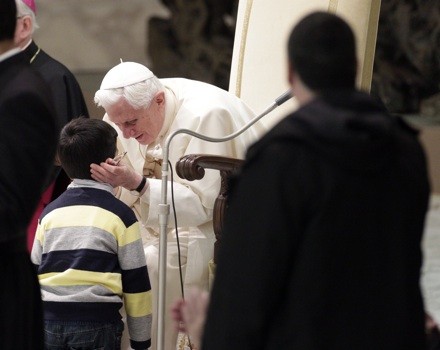
(Nyheten og bildet fant jeg her.)
Dette sa pave Benedikt i går under den ukentlige onsdagsaudiensen, da han snakket om den hellige Teresa av Avila. Han begynte forøvrig i går en nye serie om kirkelærerne. Slik starta han sin tale:
Dear Brothers and Sisters,
In the course of the catecheses that I dedicated to the fathers of the Church and to great figures of theologians and of women of the Middle Ages, I was able to reflect also on some men and women saints who have been proclaimed doctors of the Church for their eminent doctrine. Today I would like to initiate a brief series of meetings to complete this presentation of the doctors of the Church. And I begin with a saint who represents one of the highest examples of Christian spirituality of all times: St. Teresa of Avila (of Jesus). …
Les mer her – eller se en kort video (under).
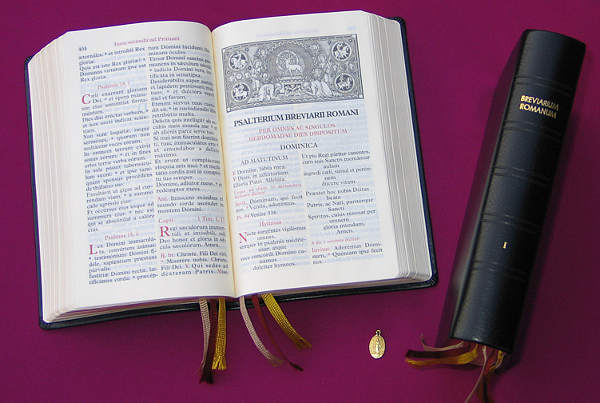
Den ankom i dag, i to flotte bind: Breviarium Romanum. Og i morgen har jeg tenkt å begynne å lese tidebønnene på gamlemåten – som pave Benedikt har gitt alle prester lov til om de ønsker det. Mye ligner på de nye tidebønnene, men det blir sikkert mange ting å lære.
Jeg nevnte mandag noen engelske katolikker som ikke er så glade for den store tilstrømningen av tidligere anglikanere. Dette kommenteres på en interessant måte på bloggen Dominus mihi adjutor – en blogg jeg aldri har sett før:
… it means that a goodly number of Anglicans and their clergy will be entering into full communion with the Catholic Church. Moreover, surely their arrival will only enrich the diversity of the Catholic Church, as they bring their own traditions, or “patrimony”, of liturgical worthiness, pastoral sensitivity and biblical engagement. They will speak an idiom clearly understood by Anglicans, who may then, we pray, feel moved to explore further the path to full communion by means of this familiar idiom.
Here, one suspects, is her problem. The Ordinariate reveals clearly that for the Catholic Church ecumenism is not about ongoing “dialogue” for its own sake. It is about encouraging and convincing Christians to enter into full communion with the Church, from which they are estranged due to actions centuries ago. If it means anything regarding the relations between the Anglican Communion and the Catholic Church it is that the Church has only one goal, ultimately, for ecumenical dialogue with Anglicans: that they return to the Church. This may disturb many Anglicans, for sure, but that is no reason to stop the progress of ecumenism. …
Jeg skal her henvise til et ganske skarpt innlegg fra en annen presteblogger – men trøsten for noen av bloggens lesere er at dette i alle fall ikke handler om luturgi! Det handler om at moderne teologi – protestantisk og katolsk – de siste år har vært ganske bibelkritisk og rasjonalistisk. Starten til denne kritikken går mer enn 150 år tilbake – selv om det ikke er mer enn 70 år siden katolikker har fått lov til å drive noen form for bibelkritikk – og det må vel også sies (syns jeg) at vi har sett en viss bedring de siste 20 år. Selv var jeg svært opptatt av og anfektet av denne bibelkritikken, rasjonalismen og fideismen som teologistudent fra 1975-82, og må innrømme at jeg på dette punktet aldri har vært skikkelig moderne. Men så over til Fr Longeneckers innlegg for et par dager siden (som har forårsaket svært mange kommentarer):
There are many problems in the Catholic Church that might be thought to be the ‘smoke of Satan’ entering the church, but for my money one thing, above all others, has been the successful work of Satan, which has undermined the church, emasculated her ministry, sabotaged the aims of the Holy Spirit and captured a multitude of souls.
It is the modernist re-interpretation of the Catholic faith. The reductionist results of modern Biblical scholarship and the infiltration of a modernist, rationalistic and materialistic mindset meant that the supernatural was assumed to be impossible, and therefore the Bible stories (and also any supernatural elements of the faith) had to be ‘de-mythologized.’ Everything supernatural within the Biblical account and within the lives of the saints and within the teaching of the church were assumed to be impossible and had to be ‘re-interpreted’ so they would make sense to modern, scientifically minded people. …
… it’s virtually triumphant within the mainstream Protestant churches, and sadly, the modern Catholic Church in the USA is riddled through with the same noxious heresy. The reason it is so obnoxious and disgusting is because priests and clergy of all sorts still use all the traditional language of the liturgy, the Scriptures and the creeds, but they have changed the meaning of it altogether. They never actually stand up and say that they have changed the meaning, and that they no longer believe the faith once delivered to the saints. …
… The faithful don’t know why their church has become like a cross between a Joan Baez concert and a political activism meeting. They don’t understand why they never hear the need for confession or repentance or hear about old fashioned terms like ‘the precious blood’ or ‘ the body, blood, soul and divinity of Our Lord and Savior» …
Erkebiskop Thomas E. Gullickson er pavens nuntius på Antillene skrev i juli 2009 om hvordan han hadde begynt å feire messen ad orientem i sit eget kapell:
I am finally coming to grips with the invitation from people I respect, first and foremost from the then Cardinal Joseph Ratzinger and now Pope Benedict XVI, to look again at certain aspects of the last forty years of liturgical reform and specifically for me as a priest and bishop to look at the question of the best stance for the priest when praying the Eucharistic Prayer at Mass. …
I really am convinced that praying the Eucharistic Prayer ad Orientem makes more sense and is therefore better. I will celebrate that way in my chapel. In other chapels and churches, when I am invited, I will celebrate as is the custom there. Remember, the Holy Father has decided to teach by example in this case. …
Sist søndag holdt samme erkebiskop en preken der han bl.a. undret seg over at pave Benedikts ønsker om liturgien ikke altid blir fulgt opp:
… Why, even three years after the issuance of Summorum Pontificum (just to name one example), are well-meaning lay folk still treated with such great disdain … When the Holy Father speaks of his will to see these two forms of the Roman Rite (ordinary and extraordinary) enrich each other, when he and others express eagerness for a recovery of the sense of the sacred in our churches and in how we worship, I am convinced that he has indicated the true nature of the rupture which has indeed occurred and needs to be mended or healed. You would think that those in communion with the Pope would seek to understand him and embrace his point of view. …
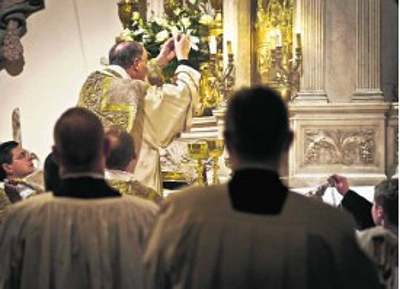
H.E. Most Rev. André-Joseph Léonard, Archbishop of Brussels and Primate of Belgium, celebrated a Pontifical Mass in the usus antiquior in Brussel’s Minim Church, where he recently erected a new apostolate of the FSSP. Les mer om det her.
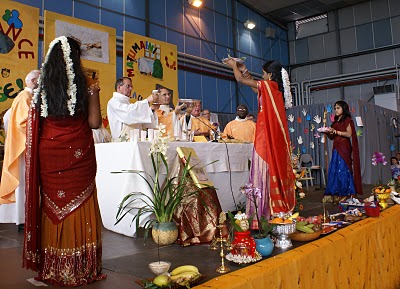
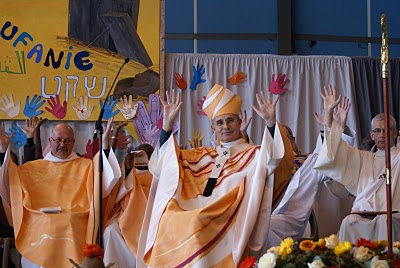
Dette er bilder av en messe biskopen av Toulouse feiret 16. januar i år – jeg har spesielt vanskelig for å forstå hva som skjer i det første bildet. (Det ser ut til å være under slutten av den eukaristiske bønn, under «Ved ham, og med ham og i ham …», og ingenting annet skal ved da løftes opp til Gud enn Kristi eget fullkomne offer!) Les mer om dette her.
Dette skrev jeg for akkurat fem år siden – på min blogg:
I dag, 1. februar, reiser min kone og jeg til Roma!
Vi skal være der i nesten et halvt år; selv skal jeg studere økumenisk teologi ved det pavelige universitetet som kalles Angelicum. Vårsemesteret i Roma begynner 20. februar, men denne uken skal jeg ned og registeres og ordne med en del praktiske ting, før vi tar en ti dagers ferie på Italias hæl, i Puglia.
Jeg håper å kunne fortsette bloggen fra Roma, litt avhengig av hvordan det teknisk legger seg til rette, med internett-tilkobling osv.
Tina Beattie underviser i ‘Katolske studier’ ved Roehampton University og svarer på spørsmål om hvorfor enkelte engelske katolikker har reservasjonen overfor pave Benedikts generøse tilbud til tradisjonelle anglikanere. Hun sa i går i et program på BBC Radio 4:
… I don’t want to call it a problem, but I think many of us are perplexed about what this means in terms of the Catholic Communion, and indeed obviously for relations between our two Churches. The Catholic Church has a unity that’s not based on likemindedness or sameness, and it’s very puzzling to know how this very homogenous, small group of likeminded people, offered a quasi-independent place within the Catholic Communion, is going to fit in and become part of us.
And is your objection partly to do with the fact that you don’t like what they stand for? Particularly on the question of women’s role in the Church?
I’m not happy about that, no. …
… shouldn’t you just welcome them into your Church?’
We should. And I think we…
You’re not really doing that… You’re saying you’d rather not have them.
That’s why I’m not saying it’s a problem, I think we’re perplexed. We don’t know yet what this welcome means. If I go to a mass of the Ordinariate, is that..? Obviously it’s part of the same Eucharistic Communion, but then, why does there need to be this separation? I welcome the riches of the Anglican liturgy coming into the Roman Catholic Church. There’s a lot to celebrate. They can bring with them enormous wealth that maybe we’ve lost in our rather more watered-down traditions. I think they’ll find that the Roman Catholic Church is a lot less aesthetic in its worship than High Anglicanism. So, there’s a big process of adjustment ahead, and of course we want them to do that. But I think many of us would feel happier if we were welcoming individuals, who’d come in – I’m a convert; I know what it feels like to make that change – if it was individuals coming in with a more open and positive attitude to why they were coming, maybe. …
Jeg leser nå Michael Davies’ bok ‘Pope Paul’s New Mass’. der han helt i starten av boka siterer hva en prest skriver i 1974. Det er veldig interessant å lese om hvordan presetne før 1970 lærte å feire messen, hvor forskjellig det er fra måten de fleste prester tenker på i dag (men kanskje det er bare oss prester som er interesserte i slike spørsmål):
I remember how, when, as a young priest, I was preparing to say my first Mass, I was drilled most strictly and told to drill myself in such a way that every word and gesture of mine at the altar of sacrifice would be exactly correct.
Everything – tone of voice, blessings, bows, genuflections, turn-rounds to the people, height and breadth at which one held extended arms–had to be as laid down in the rubrics, exactly correct. Why? Because, at the altar, one was performing the noblest action open to a human being; the sacrifice of God’s Son to God. It followed, both logically and theologically, that one had to bring to it every ounce of reverence of which a human being was capable.
And because human beings are made up of body and soul, it followed further that every word spoken, every bodily gesture undertaken, had to be tuned in with the utmost reverence to this supreme act of worship, the highest to which any man could ever aspire. Human nature being what it is, individual idiosyncrasies would come out to take from reverence, if priests were left to themselves in the matter of words and gestures at Mass.
It followed that idiosyncrasies had to be cut to a minimum. Hence, the rubrics, which bound all priests at Mass; depersonalizing them, so to say, in the interests of the reverence which men had to put forth when they offered sacrifice to God. How else could they acknowledge adequately in their hearts their total dependence on Him Who had made them from nothing, except that they manifested it in every bodily gesture that was theirs at Mass? If the mouth speaks out of the fullness of the heart, the converse is also true; the heart is filled with reverence if the mouth of the celebrating priest is trained to speak with a reverential tone and the body to express itself in a whole series of dignified gestures. I do not think I need press the point.
Man is not a desiccated calculating machine. He is a human being made up of body and soul. He worships with the whole of himself. Precisely for that reason the celebrating priest was never left to himself in the Old Mass. He was made to conform to a celebrating code; depersonalized in the interests of the dignity that had to surround the supreme sacrifice. It has always been that way wherever men have offered sacrifice, paid honor where honor is due. After all, one does not go to see the Queen in an old pair of jeans and tatty tennis shoes. I think the point is made. (Fr. Paul Crane, SJ. Christian Order. April 1974; 240-241)
Hos zenit.org kunne vi lese følgende fredag – om feiringen av liturgien – de skrev også noe lignende for noen få dager siden:
The Catechism of the Catholic Church reads: «In the liturgy of the New Covenant every liturgical action, especially the celebration of the Eucharist and the sacraments, is an encounter between Christ and the Church» (CCC, No. 1097). … In this encounter the initiative, as ever, is the Lord, who presents himself in the heart of the Church, risen and glorious. In fact, «if the figure of Christ does not emerge in the liturgy, who is its principle and is really present to make it valid, we would no longer have the Christian liturgy, completely dependent on the Lord and sustained by his creative presence» (Benedict XVI, To the Bishops of Brazil [North 2], April 15, 2010). …
… The liturgy, and in a special way the Eucharist, «is the encounter and unification of persons; the Person, however, who comes to meet us and desires to be united to us is the Son of God» (Benedict XVI, To the Roman Curia, Dec. 22, 2005). The individual and the community must be aware of being before him who is thrice Holy. Hence, the necessary attitude is one full of reverence and of a sense of wonder, which gushes from knowing oneself in the presence of the majesty of God. Was this not perhaps what God intended to express when he ordered Moses to take off his sandals before the burning bush? …
In reality, physical gestures express and promote «the intention and spiritual attitude of the participants» (General Instruction of the Roman Missal, No. 42), and enable one to overcome the danger that snares every Christian: habit …
Because of this, «a convincing sign of the effectiveness that the Eucharistic catechesis has on the faithful is surely the growth in them of the sense of the mystery of God present among us. This can be verified through specific manifestations of reverence toward the Eucharist, to which the mystagogic way should introduce the faithful» (Benedict XVI, «Sacramentum Caritatis,» No. 65). …
We see in the first place genuflection, which is done «by bending the right knee to the ground, signifies adoration, and therefore it is reserved for the Most Blessed Sacrament, as well as for the Holy Cross from the solemn adoration during the liturgical celebration on Good Friday until the beginning of the Easter Vigil.» (General Instruction of the Roman Missal, No. 274). The bowing of the head instead means reverence and honor. …
Father Juan Silvestre is a professor of liturgy at the Pontifical University of the Holy Cross and a Consultor of the Congregation for Divine Worship and the Sacraments, as well the Office of Liturgical Celebrations of the Supreme Pontiff.
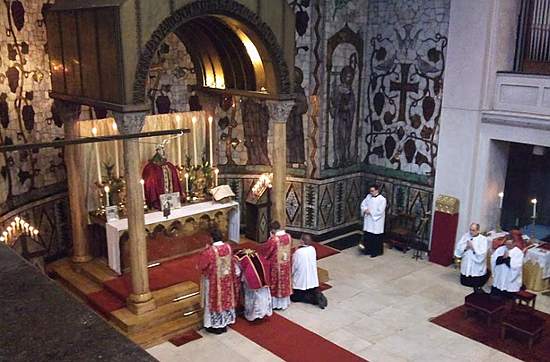
Søndag 10. april feirer Københavns biskop, msgr Czeslaw Kozon, en (tradisjonell latinsk) pontifikal høymesse i St Agneskirken i Amsterdam. FSSP er ansvarlig for arbeidet i denne kirken.
Jeg vet ikke hvorfor biskop Kozon skal feire denne messen i Amsterdam (kanskje noen andre vet), men det er en hyggelig nyhet – og det er faktisk ikke så vanskelig å lese nederlandsk:
De Agneskerk in Amsterdam is de rectoraatskerk van de St. Petruspriesterbroederschap in Nederland. In deze parochie wordt uitsluitend de traditionele Latijnse liturgie gevierd. Op hun site kondigen zij voor dit jaar twee opmerkelijke H. Missen aan in de Tridentijnse ritus: «In het jaar 2011 zullen we enkele bijzondere gasten in onze kerk mogen verwelkomen. Allereerst op zondag 10 april (Passiezondag) Zijne Hoogwaardige Excellentie mgr Czeslaw Kozon, bisschop van Kopenhagen. Hij zal die zondag celebrant zijn in een pontificale Hoogmis.

En katolsk prest i England, Fr Ray Blake, skriver på sin blogg at han ikke er så veldig entusiastisk mht til kristen enhet – eller han ser vel ikke muligheten for seg at det kan skje, i alle fall med de forskjellige protestantiske kirkesamfunn. Slik skriver han:
The Week of Prayer for Christian Unity for most of us is about lukewarm tea and stale biscuits in a damp church hall, making friends or building relationships with people who one will never ever share visible unity. It is important but I think to be honest people might be more enthusiastic if spoke about The Week of Prayer for Christian Friendship, or even Christian Co-Operation.
The great act of unity that preceded the Week of Prayer, the setting of the Ordinariate and the ordination of Fr Newton and companions highlighted the possibilities and aim of Christian Unity. For Catholics Christian Unity isn’t fuzzy nor is there anything ambiguous about it but an acceptance of the fullness of the Christian faith by other Christians. With the ancient Churches there can be real dialogue because we start from a common understanding of God, I mean a God who is Triune and Incarnate and who communicates directly through the sacraments and Tradition, with liberal post reformation Christians one sometimes wonders whether we have more in common with orthodox Jews and Muslims, at least they believe in a God who speaks to us, who gives us more than take it or leave it morality. …
Han har altså større håp om at det skal være mulig å komme til enhet med de ortodokse kirkene, og (legger han til) med de katolske gruppene som i dag ikke har fullt fellesskap med Den katolske Kirke:
The real focus of Unity ought to be first of all amongst ourselves. Is it too much today to make a distinction between those in schism and those in heresy. One of the important burdens laid on Bishops by the Second Vatican Council is to be the minister of unity, nothing new the Church has always seen him is as the focus of communion, the model of the Good Sherpherd reminds us that the Bishop is supposed to go in search of the lost sheep.
I was heartened to read the Bishop of Nice, Mgr Louis Sankalé had been to tea, or at least visited the local SSPX, strange that it should be news. Strange that it should be more acceptable to welcome into one’s pulpit or lead prayers in one’s church the local female liberal Methodist minster but trying to invite a priest of the Society of Pius X would throw up all types of problems and worst, suspicions!
Vårt Land hadde tidligere denne uka en interessant artikkel om dagens religiøse virkelighet, skrevet av Marianne Lystrup. Der påpeker hun at mens sekulære mennesker gjerne lar seg inspirere av det åndelige i vår tid (på sine egne premisser), sliter den organiserte kristendommen. Hun finner utgangspunktet for dette hos Luther, som ba folket lese og tolke Bibelen selv, fører det videre til bl.a. pietismens personlige kristentro, helt fram til dagens koldtbord-virkelighet. Hun avslutter så sin artikkel med alternativet til disse personlige, religiøse variantene – som er Den katolske Kirke:
… Som en motsats til den moderne selvbetjeningstroen, står den katolske kirke der som en mastodont og holder på sitt: Sine håpløst umoderne regler, og sine formynderske dogmer. Men de har også et tilbud som nesten er for godt til å være sant: En katolikk i sjelenød kan lene seg til kirken, sin mor, og be henne tro for seg. Det er en nådens favn som kan være god å krype inn i, når tidene er harde, og man selv ikke finner troens frø i sitt hjerte.
For den svimlende friheten som ligger i en tro man selv er fullt og helt herre over, har en kjip bakside: Ansvar. Ansvar for å skille mellom godt og dårlig, mellom juks og ekte vare på religionens koldtbord. Det kan være tungt å bære helt alene. Dessuten er jo en ikke ubetydelig side av religion, at mennesket finner sin plass i en sammenheng som er større enn det enkelte menneske.
Hvis du venter på en konklusjon her, så må jeg skuffe deg. Jeg har ikke tenkt å anbefale hverken dogmefavnen i St. Olav, inderlighetens Betel eller noen av de andre mulighetene vi har. Og jeg vil i hvert fall ikke anbefale alternativmessa som åndelig fotfeste eller populærkulturens utvannede sjelesurfing. Men vi har noe å tygge på her. Og vi har alle grunn til å glede oss over at vi har tyggefrihet.



Et referat fra bønnegudstjenesten i går kveld, i kirken San Paolo fuori le mura, ved avslutningen av bønneuken for kristen enhet, refereres pave Benedikt slik: «Enhet er et moralsk imperativ for alle kristne«. I referatet står det også:
The journey towards full Christian unity has “made great strides” in the past few years even if it has not reached its goal, one that remains “a moral imperative and a response to a specific call of the Lord. For this reason, we must defeat pessimism and the temptation to give in for this represents a lack of trust in the power of the Holy Spirit,” Benedict XVI said as he urged Catholics and all Christians to celebrate the end of the Week of Prayer for Christian Unity.
Representatives of other Churches and Ecclesial communities present in Rome took part in the ceremony in Rome’s Saint Paul Basilica Outside-the-Walls. They included a delegation of the German Lutheran Church as well as members of the Joint International Commission for Theological Dialogue between the Catholic Church and the Oriental Orthodox Churches, whose meeting is scheduled in Rome a few days from now. “Let us entrust the success of your meeting to the Lord,” the Pope told the latter, “so that it may be a step towards the much hoped for unity.” …
Slik begynte pave Benedikt sin preken under den økumenesike bønnegudstjenesten i kirken Paulus utenfor murene i Roma i går kveld:
Brothers and Sisters,
Following the example of Jesus, who on the eve of his Passion prayed to the Father for his disciples «that they may all be one» (John 17:21), Christians continue to invoke incessantly from God the gift of this unity. This request is made more intense during the Week of Prayer, which ends today, when the Churches and ecclesial Communities meditate and pray together for the unity of all Christians.
This year the theme offered for our meditation was proposed by the Christian communities of Jerusalem, to which I would like to express by heartfelt gratitude, accompanied by the assurance of affection and prayer either on my part or on that of the whole of the Church. The Christians of the Holy City invite us to renew and reinforce our commitment for the re-establishment of full unity meditating on the model of life of the first disciples of Christ gathered in Jerusalem: … …
P. Nicola Bux skriver hos zenit.org om hvordan presten på mange måter uttrykker møtet med det hellige når han feirer messen:
Faith in the presence of the Lord, and in particular in his Eucharistic presence, is expressed in an exemplary manner by the priest when he genuflects with profound reverence during the Holy Mass or before the Eucharist.
In the post-conciliar liturgy, these acts of devotion have been reduced to a minimum in the name of sobriety. The result is that genuflections have become a rarity, or a superficial gesture. We have become stingy with our gestures of reverence before the Lord, even though we often praise Jews and Muslims for their fervor and manner way of praying.
More than words, a genuflection manifests the humility of the priest, who knows he is only a minister, and his dignity, as he is able to render the Lord present in the sacrament. However, there are other signs of devotion.
When the priest extends his hands in prayer he is indicating the supplication of the poor and humble one. … In proceeding to the altar, the priest must be humble, not ostentatious, without indulging in looking to the right and to the left, as if he were seeking applause. Instead, he must look at Jesus; Christ crucified is present in the tabernacle, before whom he must bow. …
The reverent kiss of the altar follows and eventually the incense, the sign of the cross and the sober greeting of the faithful. Following the greeting is the penitential act, to be carried out profoundly with the eyes lowered. In the extraordinary form, the the faithful kneel, imitating the publican pleasing to the Lord. …
He will touch the holy gifts with wonder … He will bow his head over the bread and the chalice in pronouncing the consecrating words of Christ and in the invocation of the Holy Spirit (epiclesi). He will raise them separately, fixing his gaze on them in adoration and then lowering them in meditation. He will kneel twice in solemn adoration. …
After communion, silence for thanksgiving can be done standing, better than sitting, as a sign of respect, or kneeling, if it is possible, as John Paul II did to the end when he celebrated in his private chapel, with his head bowed and his hands joined. He asked that the gift received be for him a remedy for eternal life, as in the formula that accompanies the purification of the sacred vessels; many faithful do so and are an example. …
I går sa pave Benedikt følgende:
At the conclusion of an annual week of prayer devoted to overcoming divisions in Christianity, Pope Benedict XVI has warned that hard political choices over “the family, marriage and sexuality” cannot be played down for the sake of preserving good relations among the various Christian denominations.
Such issues form the heart of the contemporary culture wars, and Benedict called for a united front among Christians on these debates, “which cannot be minimized or avoided simply to avoid endangering the agreement we’ve already achieved.”
The pontiff’s remarks came in an audience this morning with a delegation from the Lutheran Church in Germany, to mark the end of the Jan. 18-25 Week of Prayer for Christian Unity. …
Det er ikke første gang pave Benedikt snakker om moderne teknologi; nå sier han at den kan være nyttig for å spre evangeliet – men han peker også på begrensninger og problemer:
Pope Benedict XVI invited Christians to join online social networks in order to spread the Gospel through digital media and discover «an entirely new world of potential friendships.»
At the same time, the pope warned of the limits and the dangers of digital communication, including the risks of constructing a false online image and of replacing direct human contact with virtual relationships. …
«The new technologies allow people to meet each other beyond the confines of space and of their own culture, creating in this way an entirely new world of potential friendships,» he said.
The pope added that digital communication has built-in limits, including the one-sidedness of the interaction and «the tendency to communicate only some parts of one’s interior world.» The creation of an artificial online image instead of an authentic one «can become a form of self-indulgence,» he said.
The great potential of social networks for building relationships makes it a natural place for the church to be present, he said. But there is a «Christian way» of being online — through communication that is «honest and open, responsible and respectful of others,» he said. …